CROP UPDATE NO 3 - INSECT PESTS and DISEASES - 17 APRIL 2020
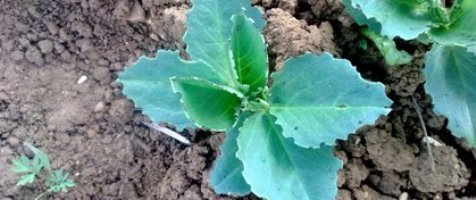
Insect Pests….
Pea and bean weevil
Pea and bean weevils have been found in traps in Lincolnshire following warm weather over the last week. A monitoring system is available that detects adults as they migrate in early spring, consisting of five cone traps containing pheromone lures. It can be used to aid decision making in the following ways:
- Identifies seasons when weevil numbers are low and crops do not require treatment;
- Identifies time of peak activity and best timing of applications;
- Reduces the need for prophylactic spraying;
- May allow the selection of drilling time to avoid peak weevil activity;
Traps are sited on a grass margin or headland of a field that was cropped with peas or beans in the previous year and should be checked three times each week. A threshold is reached when an average of more than 30 weevils is recorded per trap on any one occasion. When a threshold is reached, crops that have just emerged or are likely to emerge within 10 days are likely to be at risk. Insecticides should be applied at first signs of crop damage, seen as u-shaped notching on leaf edges, especially where there is a history of severe damage. A second spray may be required if crops are growing slowly. If a threshold is not reached or occurs more than 10 days before crop emergence, insecticides are not required. Winter beans seldom require treatment as they are well established before attack occurs.
Traps are available from Agralan Ltd. https://www.agralan-growers.co.uk/
Aphids
The general message from the AHDB Aphid News bulletins and the Rothamsted Insect Survey is that aphids will be flying around 1-3 week earlier in Scotland and Northern England to around 4 weeks earlier over much of England from the Wash southwards than they would be expected to historically. There have been no pea aphids or black bean aphids recorded yet, although in response to the Covid-19 pandemic, the Rothamsted Insect Survey is at this time operating at reduced capacity. The team will process as many samples as possible to produce weekly results, but substantial disruption to the normal reporting service is expected. Most of the suction-trap network is currently operating on a weekly trapping regime with several sites unable to send samples. For information about aphid management in legumes go to https://www.pgro.org/agronomy-guides-publications/ or contact the PGRO advisory service on 01780 782585.
Pea moth
Order pea moth traps now ready to be put in place in early to mid-May. Traps are available from the following suppliers:
Dragonfli, Unit 4 Rippers Court, Sible Hedingham, Halstead, Essex, CO9 3PY, UK Tel: 01376 563322 www.dragonfli.co.uk
Andermatt UK, 47 Compton Road, Brighton, West Sussex, BN1 5AL, UK
Tel: 07939 395059 Email: contact@andermattuk.com www.andermattuk.com
Agralan Ltd., The Old Brickyard, Ashton Keynes, Swindon, SN6 6QR, UK
Tel: 01285 860015Email: sales@agralan.co.uk www.agralan-growers.co.uk
Traps are received in sets of one or two, depending on the supplier. One set is required for each block of peas, i.e. a farm having all the pea fields within a restricted area need only purchase one set of traps, but in fields of 50 ha or more two sets are required.
Traps must be placed in the pea crop by the middle of May and examined at two-day intervals. The number of moths caught by each of them is noted on each occasion. Traps can be suspended on pheromone trap pole kits or fence posts in the field and should be placed at canopy height, moved upwards at intervals as the crop grows.
Combining peas
When using two traps the threshold, which determines whether treatment is necessary, is 10 or more moths caught in either of the two traps on two consecutive occasions.When using a single trap, the threshold is 20 or more moths caught in the trap on two consecutive occasions. Timing of sprays must be related to egg development and this is affected by temperature.
A spray date can be obtained from the PGRO website - www.pgro.org based on a computer prediction, 3 - 4 days after reaching a threshold. This service will start in May 2020.
On the predicted spray date, crops which are at the first pod set stage, or which have flowered should be sprayed, but later crops should only be sprayed when they reach first pod set. Crops with flat pods are susceptible to damage. A second application should be applied 10-14 days later.
Vining peas
Where the acceptable level of damage is much lower in vining peas, the threshold used for combining peas is not suitable and therefore the traps should only be used as a guide as to the presence of moths. In areas where damage has been a problem in the past, crops which are at the first pod set stage should be treated with a single application. Take care to observe the minimum interval between application and harvest.
For products available to control pea moth please see our technical updates TU14 (checklist of fungicides and insecticides for vining peas) and TU15 (checklist of fungicides and insecticides for combining peas) at www.pgro.org.
Diseases…
There have been some reports of chocolate spot and Cercospora in winter beans.
Chocolate spot is encouraged by long periods of overcast and wet weather conditions. Winter beans are more susceptible to infection, especially where plant populations are high. Spring beans and broad beans can develop chocolate spot during wet spring and summer conditions. The disease develops as small, circular, chocolate coloured spots on the lower leaves. These become larger and may coalesce to form a greyer coloured lesion extending over the leaf surface. Stems and pods can also develop a covering of spots or flecks. Severe infections can result in defoliation. Protectant fungicides should be applied at first pod if spotting is seen on the leaves. If severe spotting is seen earlier in the season, the first spray should be moved forward. A second spray should be applied 3-4 weeks later if spotting continues to develop on the upper parts of the plant. A range of products and mixtures are approved.
Cercospora leaf spot has been reported more frequently in UK field beans in the last few years and there have been reports of Cercospora in winter bean crops in 2020. The disease persists in crop residues in the soil and is dispersed by wind and rain to infect young plants, particularly in fields planted close to previous year’s crops. In some countries the disease can cause between 5 and 10% yield loss when infection is severe. Lesions are dark brown to black with a grey centre, and with a characteristic zonal pattern. Applications of products containing tebuconazole or chlorothalonil are effective to control the disease. Products containing chlorothalonil may only be used until 20 May 2020.
(Edition Number 3: CB20-03)
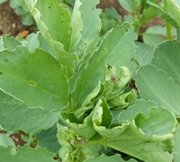
Pea and bean weevil adult and notching
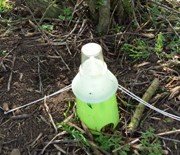
Weevil trap
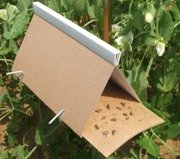
Pea moth trap
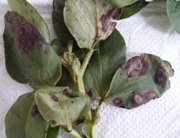
Cercospora zonata in winter field beans



